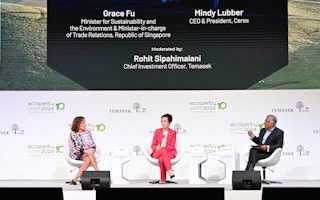Southeast Asia’s reliance on coal to power its fast-growing economies is eating up the region’s carbon budget that could be used to develop other high-value industries, Singapore’s environment minister has said.
To continue reading, subscribe to Eco‑Business.
There's something for everyone. We offer a range of subscription plans.
- Access our stories and receive our Insights Weekly newsletter with the free EB Member plan.
- Unlock unlimited access to our content and archive with EB Circle.
- Publish your content with EB Premium.
Speaking at the Ecosperity sustainability conference on Monday, Singapore’s Minister for Sustainability and the Environment Grace Fu said Southeast Asia needs to think about the “most pollutive source of energy” [coal] as it decarbonises.
“If we are using our [Southeast Asia’s] carbon budget just for coal-fired power plants, we will be left with very little for other [carbon-intensive] manufacturing activities that we aspire to have,” she said without detailing which industries she was referring to, though Fu highlighted that Southeast Asia – home to about 670 million people – has a population that is young, growing and “aspiring for better things in life”.
Countries in the region should pursue renewable energy, and shed their reliance on coal, she said.
Southeast Asia is the only region in the world where coal is projected to grow in the energy mix, according to the International Energy Agency (IEA). Electricity demand in the regional bloc has grown by 80 per cent since 2000, with fossil fuel use doubling in that time period.
Eight out of 10 Southeast Asian nations have committed to achieve net-zero emissions, although few pledges are in line with the Paris Agreement aim to curb planetary warming to 1.5°C above pre-industrial levels, partly due to ongoing coal use in countries such as Indonesia, Vietnam and Malaysia.
Fu spoke against fossil fuel subsidies, which she said are difficult to remove “in an election year”, where governments are thinking more about political realities. 2024 has been billed so, with 2 billion people in over 50 countries set to cast their votes, and Fu said the biggest and hardest task is ensuring climate remains on the agenda for political leaders around the world even with many distractions.
“Some renewables have reached commercial parity, but if fossil fuels are still subsidised, [governments are] going to have to go against economics to substitute them [with renewable power],” she said.
IEA chief energy economist Tim Gould said that while Southeast Asia may have long-term net-zero ambitions, “much faster deployment” of fossil fuel alternatives was needed to deliver on these targets.
A key issue with Southeast Asia’s growing arsenal of coal-fired power plants is that many are young, presenting the problem of large amounts of “unrecovered capital”, said Gould.
An attempt to wean Indonesia, Southeast Asia’s largest economy, off coal by funding the closure of its coal plants early has stalled, partly over a disagreement over the country’s captive coal plants.
Singapore has a very low exposure to coal, which accounts for less than one per cent of its energy mix, although the country’s major banks have been targeted by environmental groups for funding new coal-fired plants around the region.
Singapore’s big three banks, DBS, OCBC and UOB – Southeast Asia’s largest – have all committed to exit coal power, albeit not until 2039 at the earliest.
Fu said that an aspiration to develop a regional energy grid based on renewable energy cannot be left to Singapore alone, which has been one of Southeast Asia’s key players in striking cross-border renewables deals with countries including Laos, Thailand and Vietnam.
Singapore is aiming to import 4 gigawatts (GW) of low-carbon electricity by 2035, equivalent to 30 per cent of its supply, as the city-state moves to reduce its dependence on fossil gas, which accounts for 95 per cent of its energy mix.
“Singapore’s [renewable energy procurement] volume can be that baseload [for a regional energy grid] but it will not be sufficient. We need all countries to be participating in renewable energy,” she said.
Investments in renewable energy in Southeast Asia rose by 20 per cent in 2023 compared to 2022, according to data from Bain, a consulting firm, presented at Ecosperity. The biggest year on year increases were seen in Indonesia, the Philippines and Malaysia, while investments were down in Singapore and Vietnam.










